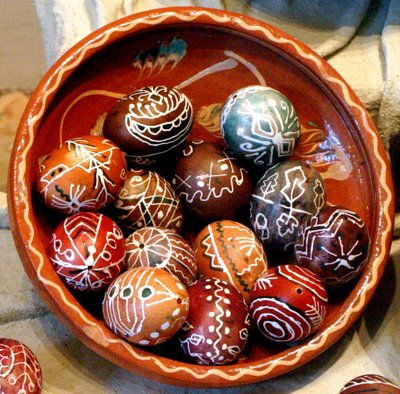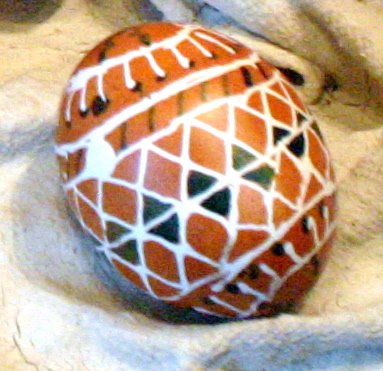
I found these interesting, but odd eggs at one of the museums in Trypillia. Initially I merely found them oddly attractive, but it wasn't until a bit later that I began to wonder how they were made.
Most Ukrainian pysanky are made with a simple wax-resist technique. Eggs are place through a series of dye-baths, from light to dark, and areas waxed in to preserve the underlying color. In some parts of Ukraine, bleaching is done; once all the colors have been used, the egg is bleached to a final white color.
That's about as fancy as most traditional Ukrainian pysanky get.
Here in the diaspora we have gotten more creative. Light blue, a color rarely seen on Ukraine pysanky, is often used, and eggs are processed with an orange rinse, or colors removed with various cleaning agents, to allow a greater palette of colors. Bleaching is more common, as is etching. All sorts of modern tricks and techniques are used to make ever fancier pysanky.
So what is so unusual about these simple pysanky?
 Simply that there are black accents on the eggs.
Simply that there are black accents on the eggs.Black is normally the final color when it is used, but here it is merely an accent--a few dots here, a line there, a few diamonds filled in elsewhere.
How was this done?
 One way would require a lot of work, more than is normally seen with traditional pysanky. It would require coloring in, with wax, of all the colored areas, leaving only those few spots that should be black uncovered.
One way would require a lot of work, more than is normally seen with traditional pysanky. It would require coloring in, with wax, of all the colored areas, leaving only those few spots that should be black uncovered.I doubt that this pysankarka did that.
I think that a bicolored egg was created (white designs on a colored background), and then the black designs added with a brush before the wax was removed. It is a simple and clever trick, but one that I haven't seen before in traditional pysanka making.
Any other theories out there?
No comments:
Post a Comment